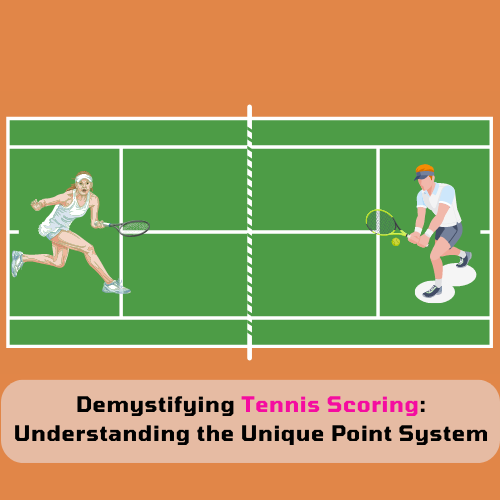Have you ever wondered how tennis scoring works? Keeping score in tennis can seem perplexing, especially for beginners. In this comprehensive guide, we will unravel the mysteries of tennis scoring and provide you with a solid understanding of the point system. Whether you’re a novice or looking to brush up on your knowledge, this article will equip you with the essential information you need to keep score in tennis like a pro.
Table Of Contents
- The Origins of Tennis Scoring
- Guide Tennis Scoring for Beginners: Who Starting a Match?
- Understanding the Tennis Points System
- The Structure of a Tennis Set
- Switching Sides: Why and When
- Tennis Scoring Etiquette
- Managing Forgotten Scores: How Tennis Scoring Works
- The Tennis Tiebreaker: Breaking the Deadlock
- Scoring Differences: Singles vs. Doubles Matches
- Essential Tennis Terms to Know
The Origins of Tennis Scoring
The origins of tennis scoring can be traced back to the medieval era, with the precise details somewhat ambiguous. It is believed that the scoring system started to take shape in the 16th century, primarily in France and England. During this time, the game was known as “real tennis” or “royal tennis.”
Initially, tennis scoring was based on a clock face, where the hour hand represented the number of points a player had won. As the game evolved, the scoring system transformed into a series of numerical sequences that we recognize today.

Tennis also incorporates a unique scoring term called “love,” which means having zero points. The exact origin of the term “love” is uncertain, but it may have derived from the French word “l’œuf,” meaning “the egg.” The similarity in shape between a zero and an egg could have led to the term’s adoption.
Read more detail: The evolution of tennis scoring: A Comprehensive guide
Decoding Tennis Scoring: Explaining the Origins of ’40 Love’ in Tennis
Guide Tennis Scoring for Beginners: Who Starting a Match?
To determine who will serve first and which side each player will start on, a common method is to settle it through a coin toss or what is commonly known as a spin-off. However, let’s clarify the process to avoid any confusion.
The first step in the spin-off is deciding who will perform the racket spin and who will call it. It doesn’t matter who takes on which role, so someone can volunteer for either task.
Now, take a look at the end of your tennis racket handle. Depending on the brand of your racket, there will be a letter or picture engraved or printed there. For example, if you have a Wilson racket, your opponent will call out either “M” or “W.” In the case of a Prince racket, it will be either “P” or “D.” You get the idea.
Once the roles are assigned, the person holding the racket spins it in their hand until the opponent says “stop.” At that point, they should check the letter or shape at the bottom of the racket handle. If the opponent correctly called out the letter or shape, they have the privilege to choose between serving first or picking which side they would like to start on.
If they opt to serve first, you then have the opportunity to select the side of the court. Conversely, if they choose their preferred side, you will have the advantage of making the first serve of the game.
Remember, this process adds an element of fun and fairness to the game, ensuring a fair start for both players. So, grab your racket and get ready for an exciting match!
Understanding the Tennis Points System
To grasp tennis scoring, it’s essential to break down the points system. We’ll explain how points are awarded in tennis and the significance behind the “15-30-40” scoring method. By comprehending this system, you’ll gain a deeper understanding of how games are won and how players progress through a match.
Read more detail: THE EVOLUTION OF TENNIS SCORING: UNDERSTANDING 15, 30, 40
The Structure of a Tennis Set
In tennis, a set is a collection of games that players compete in to determine the winner of a larger portion of the match. To win a set, a player must win a certain number of games.
Traditionally, a set is played to six games, with the exception that if the score reaches 5-5, a player must win by two games to secure the set. For example, if the score is 6-5, the player in the lead must win one more game to win the set, making it 7-5. However, if the score becomes 6-6, a tiebreaker is often used to determine the winner of the set.

Once a player wins a set, they earn a point in the overall match. Matches are usually played as the best of three or five sets, depending on the level of competition or tournament rules. In a best-of-three-set match, the first player to win two sets emerges victorious. In a best-of-five-set match, the first player to win three sets claims the win.
Switching Sides: Why and When
During a tennis match, players switch sides of the court after an odd number of games, typically every odd game. The primary reason behind this practice is to ensure fairness and equal opportunity for both players.
Switching sides allows players to experience the same playing conditions on both ends of the court. Factors such as wind, sun, and court surface can affect the game, and by switching sides, players have a chance to adjust their strategies and tactics accordingly.
For example, if there is a strong wind blowing in a particular direction, switching sides ensures that both players face the same challenging conditions. This maintains a level playing field and avoids giving one player an unfair advantage due to wind assistance or resistance.
Tennis Scoring Etiquette
Good sportsmanship and etiquette are vital aspects of tennis scoring. Proper conduct includes calling out the score clearly and handling disputed calls with grace and respect. By adhering to these guidelines, you’ll create a positive and fair environment for yourself and your opponent.
Managing Forgotten Scores: How Tennis Scoring Works
In the heat of a competitive tennis match, it’s not uncommon for players to momentarily forget the score. It can happen due to the intensity of the game, distractions, or simply a momentary lapse in concentration. However, there are practical strategies to manage these situations and ensure accurate scoring without causing unnecessary disruptions.
One effective method to recollect the score is by using a mnemonic device. Mnemonics are memory aids that help you remember information. In tennis, a popular mnemonic is “up by one, serve is done.” This simple phrase reminds you that when a player is leading by one point and the serving has ended, it’s time to switch sides and continue the game.
Another approach is to communicate with your opponent. During a break in the game, politely ask your opponent if they recall the score.
If both players are unsure about the score, you can consult the umpire or refer to the electronic scoreboard if one is available. The umpire or official scorer usually keeps track of the score and can provide accurate information to resume the game smoothly.
Read More: Decoding the Peculiarities of Tennis Scoring: A Comprehensive Guide for Beginners
The Tennis Tiebreaker: Breaking the Deadlock
In tennis, when games or sets become tied, a tiebreaker comes into play to break the deadlock and determine the winner. The purpose of a tiebreaker is to provide a clear and decisive outcome in situations where regular scoring methods have resulted in a tie.
Generally, tiebreakers are played as a separate game within a set, and the player or team that reaches a predetermined number of points first wins the tiebreaker and, in some cases, the set. The most commonly used format is the “7-point tiebreaker,” where the first player or team to reach seven points with a margin of at least two points wins the tiebreaker.

To start a tiebreaker, the player who is due to serve first in the tiebreaker serves the first point. After that, the serving alternates between the players or teams after every two points. For example, if Player A serves the first point, Player B serves the next two points, and it continues in this manner until the tiebreaker is complete.
It’s important to note that tiebreakers have specific scoring conventions. Instead of using the traditional “15-30-40” scoring system, tiebreakers use a simple “1-2-3-4” sequence. Each point won is counted as one, and the first player or team to reach seven points, with a lead of at least two points, wins the tiebreaker. For instance, if the score is 6-6 in a set, and Player A wins the first point in the tiebreaker, the score would become 1-0.
Scoring Differences: Singles vs. Doubles Matches
Tennis scoring indeed has slight variations between singles and doubles matches.
In singles matches, which involve one player on each side of the net, the scoring system remains straightforward. The standard “15-30-40” scoring sequence is used, where players accumulate points to win games, sets, and the match. The first player to win four points and have a two-point lead wins the game. To win a set, players must win six games with a margin of at least two games. If the set reaches a 6-6 tie, a tiebreaker is usually played to determine the winner of the set.
On the other hand, doubles matches, which feature two players on each side of the net, introduce additional complexities to the scoring system. The most notable difference in doubles scoring is the inclusion of an extra layer called “team scoring.” While the principles of accumulating points and winning games, sets, and the match remain the same, the scoring language differs. Instead of addressing individual players, the team’s collective score is used during doubles matches.
Essential Tennis Terms to Know
To navigate tennis scoring effectively, it’s crucial to be familiar with key terms. We’ll provide concise explanations for terms such as “let,” “match point,” “fault and double fault,” and “ace.” By grasping the meaning and significance of these terms, you’ll enhance your comprehension of tennis scoring.
Here are concise explanations for some of the essential tennis terms related to scoring:
- Let: A let occurs when a served ball touches the net but still lands within the correct service box. In this case, the server is allowed to retake the serve without any penalty, and the point is replayed.
- Match point: Match point refers to a critical point in a match where the leading player or team has an opportunity to win the entire match. It occurs when the opposing player or team is one point away from losing the match.
- Fault and double fault: A fault is called when the server fails to deliver a legal serve by hitting the ball into the correct service box. It results in the server losing the point. A double fault occurs when the server commits two consecutive faults, resulting in the loss of the point.
- Ace: An ace is a serve that lands in the correct service box and remains untouched by the opponent, resulting in the server winning the point outright without a return shot. Aces are considered powerful and effective serves.
With a thorough understanding of tennis scoring, beginners can confidently enter matches and fully immerse themselves in the exciting world of tennis.
By following the guidelines provided in this post, you’ll be equipped to keep score accurately and appreciate the nuances of the game. Remember to enjoy the journey, and may your newfound knowledge enhance your tennis experience.

